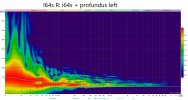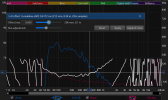-
WANTED: Happy members who like to discuss audio and other topics related to our interest. Desire to learn and share knowledge of science required. There are many reviews of audio hardware and expert members to help answer your questions. Click here to have your audio equipment measured for free!
You are using an out of date browser. It may not display this or other websites correctly.
You should upgrade or use an alternative browser.
You should upgrade or use an alternative browser.
Creating bass weight and impact?
- Thread starter Jimshoe
- Start date
-
- Tags
- bass weight
Change the graph to % up the top left, and it's best to "plot normalised" on that view too.I have not used REW before, so I don't know what I have done wrong. But my measurements looks nothing like yours. This is after Dirac Bass Control and my Denon X4800H set at Neural X soundfield.
View attachment 329474
View attachment 329475
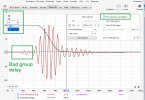
It seems your response has significant group delay below ~200Hz. Perhaps you have high pass filters and/or shelf filters that are causing this?
As I was doing that screenshot, I rediscovered the "Schroeder Integral" plot, which is a sort of "energy left" metric. Yours is decent having only 3% left at the end of the burst. Compare that to my untreated room that I posted before where there is still ~30% left after the burst.
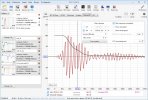
Svend P
Active Member
The subwoofers are connected to 4 Crown XLS 2500, which are set to lowpass at 200 Hz, so I don't get hiss from the subs. And the Denon is set to a crossover at 80 Hz, and Dirac has a crossover at 70 Hz on my pc.
But I think I made a slight error. 3 of my 4 subwoofers were turned of, because I wanted to test what the Denon's tactile transducer setting did for the sub playing into the back of my sofa. So I have attached a new measurement with all 4 subs on

But I think I made a slight error. 3 of my 4 subwoofers were turned of, because I wanted to test what the Denon's tactile transducer setting did for the sub playing into the back of my sofa. So I have attached a new measurement with all 4 subs on
Attachments
ernestcarl
Major Contributor
The subwoofers are connected to 4 Crown XLS 2500, which are set to lowpass at 200 Hz, so I don't get hiss from the subs. And the Denon is set to a crossover at 80 Hz, and Dirac has a crossover at 70 Hz on my pc.
But I think I made a slight error. 3 of my 4 subwoofers were turned of, because I wanted to test what the Denon's tactile transducer setting did for the sub playing into the back of my sofa. So I have attached a new measurement with all 4 subs on
View attachment 329486
Try viewing the wavelet spectrogram:



*Bass time smearing above 150 Hz (~Schroeder freq.) should not be over-equalized using FIR filtering.
Filtered IRs:




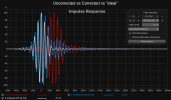

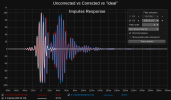
Bass time domain "room EQ correction" should improve the transient response a bit which should also (if done right) improve the perceived "weight and impact". The upper bass region ~150 Hz and up is going to require acoustic treatment.
Attachments
throw on some chocolate chip trip from tool. an outstanding drum solo. if youre stuff is good and set up well, you'll be able to hear the note attack crisply.As long as I have tested this it's even higher,at 100-120Hz or so,that's where kick drums seems to have the greater energy.
Just put a song with a drums playing solo and observe this in an RTA.The amount of energy at 100-150Hz is huge.
i find plenty of tactile sensation at 80+ with this song and most definitely from mouth of kala by gojira. their kick drums come out like gangbusters.
might not be concert level spl at 80+.
ive got some pedestrian 12 inch sealed subs and full range towers from jbl.
Last edited:
My question then is what creates the hard (in a good way) visceral bass sound that you hear at concerts? Can it be created at home?
It can be done. First rule: There is no replacement for displacement
Second rule: There is really no replacement for displacement.
Third rule: Goto first rule.
Try viewing the wavelet spectrogram:
View attachment 330242 View attachment 330243 View attachment 330244
*Bass time smearing above 150 Hz (~Schroeder freq.) should not be over-equalized using FIR filtering.
Bass time domain "room EQ correction" should improve the transient response a bit which should also (if done right) improve the perceived "weight and impact". The upper bass region ~150 Hz and up is going to require acoustic treatment.
Is the corrected one just done by EQ or also room treatment?
I have only used room treatment right now but are thinking I maybe should try some EQ.
Attachments
House curve with a 15-20dB tilt. 110dB at the low end.
ernestcarl
Major Contributor
Is the corrected one just done by EQ or also room treatment?
I have only used room treatment right now but are thinking I maybe should try some EQ.
I don't know what room treatment @Svend P has done in his room.
"Corrected" response is just the simulated outcome after applying some mixed phase EQ (via convolution or A*B arithmetic function) to the original uncorrected measurement. In certain situations it may be possible to get better results if one has full access to each channel/driver for DSP correction.
Take a bunch of measurements with a calibrated microphone and see what the default response is at your MLP (compare it to other people's posted measurements) and consider your own use-case scenario and if you're really willing to add/invest additional complexity in your current setup. I don't apply EQ to all my headphones/loudspeakers (e.g. bluetooth smart speakers).
Live sound engineer here. There are lots of differences between live and home.
Here are the differences I can think of right now:
1 - Live mixes can be very different to studio mixes
2 - PA systems can be quite far from flat
3 - Outdoor bass is different to indoor bass
I'd like to mention that I'm not one of those sound engineers that aims to have a small jazz set cave your chest in with bass. My mixes are pretty balanced, and I've been accused of not-pushing-enough-bass before now.
I've just finished soundchecking with a blues/Americana type band. With a sensible (genre-appropriate) balance out-front, the bass drum hits were metering +6dB to +10dB over the "nominal" level of the music. NB - this is a reasonably flat PA sytem. There's a reasonable amount of "punch" in the audience area, within reason: it's a 26" bass drum, tuned pretty low. The big round sound is what the drummer is going for, so there's not loads of the 70-100Hz "punch" to go around. I could apply some processing and get it to really smack everyone in the chest, but it's not that sort of gig.
In the studio, things are very different: the mix must sound as good as possible through a much wider range of reproduction systems. Laptop speakers, phone speakers (if anything, my phone sounds better than my laptop), table-top radios, £10 earphones... The list is long before we get to "decent home audio setup".
As a result, studio mixes must ensure that your average crappy radio doesn't go "crunch" on the bass drum before you can hear the vocals clearly. That means compressors and limiters all over the place, squishing everything together.
All of that processing will reign in the bass drum. It'll "fit in" nicely, rather than "punch through". The latter is perfectly allowed and desirable in live reinforcement. That +6-10dB I mentioned earlier simply won't be there on the studio mix.
It's pretty much impossible to undo all of this processing, but it might be worth playing around with an expander (or even, sample replacement mixed back in) to widen the dynamic range of the music and maybe re-introduce some "punch".
Next up, let's look at PA systems. Context: we're aiming for "full-range" reproduction. ie, a reasonable amount of bass on-tap.
Small PA systems won't typically have subwoofers. They'll just use a pair of 12" or 15" speakers. The better models can put out a useful amount of "punch", but will still struggle to provide much LF output compared to a subwoofer of equivalent size. As expected, an amplifier + driver trying to reproduce a wide frequency range (50Hz-2kHz) will easily be overloaded if you want a lot of bass.
These speakers might reach flat down to about 70Hz, but I'd consider that the bare minimum of LF reproduction. It sounds reasonable, until you hear something that goes deeper.
A better approach in the small-PA-system world is to use a subwoofer or two, of the size of the main speakers you would've got, and then use mains the next size-or-two down. ie, where a pair of 12" mains might do the job, a pair of 12" subs with 10" mains will be better.
Some LF extension may be gained, but the reduction in distortion and/or improvement in headroom is the real benefit there.
A side-note on PA speaker specs: they're mostly BS. I wrote this article: https://www.prosoundweb.com/spec-wars-looking-inside-loudspeaker-spl-specifications/
In frustration at the industry, back in 2017. It gained international recognition, with the head of engineering at EV, the guys working on M-Noise, and other sound engineers getting in touch to discuss things further. M-Noise is the only testing I'd endorse or recommend for testing the output capability of a loudspeaker.
End sidenote.
Moving towards medium-sized PA systems, there will typically be 2-4x 18" subwoofers with a pair of 12" main speakers covering >100Hz. A good 18" subwoofer will be flat to around 40Hz. IMO, this is a sensible compromise. It'll cover the LF demands of 95% of music, without being ridiculously large or hamstrung on SPL. NB - going an octave down requires 4x the cone area to maintain SPL, and when it gets to larger-scale productions, that's 1x truck vs fo
As you get to the large-scale stuff, the standard subwoofer is a 2x18". Ported box. If you want to go louder, use more. These will typically also be flat to 40Hz, but some can dig deeper. Typically only to the mid/low-30s, though, unless you find something intended specifically for genres that require high levels of VLF.
As you move towards the more capable PA systems, the system technician (the person who sets up and tunes the PA system - typically this is for larger productions) might provide the FOH engineer a "LF haystack", and/or "subs-on-Aux". They'll work it out between them, according to the FOH's engineer's preferences.
The former is deliberately introducing a LF boost into the overall tonality of the PA system. I've heard of this being as much as 20dB. ie, you set off with a flat response, and then stick a +20dB low shelf boost on there.
More typical might be +10dB. I prefer a flat response.
The latter is a separate feed from the mixing desk, where the FOH engineer can choose which channels get sent to the subwoofers (as well as the main speakers), and how much is sent. For example, you might want more sub for the bass drum than the floor tom.
Not sending a channel to the subwoofers is like adding a highpass filter on there, since that's what's being applied for the main speakers in the system processor.
We can see, then, that there's a lot of potential for extremely bass-heavy reproduction in live sound. The FOH engineer will choose how much of that LF output to actually make use of. It will be pretty rare to get much content below 40Hz, though.
Finally, I'd like to suggest something that I don't know as much about.
In an acoustically-small room, bass is essentially arriving from all directions. The net effect on us, then, is an overall compression/expansion force.
Outdoors, there'll be a pressure gradient: bass is only arriving from in front of us, so pressure/force is applied there first. While our ears don't necessarily perceive directionality at LF, I'm willing to bet the physical sensation of bass at equal SPLs, indoors vs out, is quite different.
That's all for now. The band is on soon and there are a couple of things I ought to attend to. In my next post, I'll discuss a PA system which I deployed recently which actually had a rising response towards the LF, peaking at 18Hz. It was a lot of fun.
Chris
Here are the differences I can think of right now:
1 - Live mixes can be very different to studio mixes
2 - PA systems can be quite far from flat
3 - Outdoor bass is different to indoor bass
I'd like to mention that I'm not one of those sound engineers that aims to have a small jazz set cave your chest in with bass. My mixes are pretty balanced, and I've been accused of not-pushing-enough-bass before now.
I've just finished soundchecking with a blues/Americana type band. With a sensible (genre-appropriate) balance out-front, the bass drum hits were metering +6dB to +10dB over the "nominal" level of the music. NB - this is a reasonably flat PA sytem. There's a reasonable amount of "punch" in the audience area, within reason: it's a 26" bass drum, tuned pretty low. The big round sound is what the drummer is going for, so there's not loads of the 70-100Hz "punch" to go around. I could apply some processing and get it to really smack everyone in the chest, but it's not that sort of gig.
In the studio, things are very different: the mix must sound as good as possible through a much wider range of reproduction systems. Laptop speakers, phone speakers (if anything, my phone sounds better than my laptop), table-top radios, £10 earphones... The list is long before we get to "decent home audio setup".
As a result, studio mixes must ensure that your average crappy radio doesn't go "crunch" on the bass drum before you can hear the vocals clearly. That means compressors and limiters all over the place, squishing everything together.
All of that processing will reign in the bass drum. It'll "fit in" nicely, rather than "punch through". The latter is perfectly allowed and desirable in live reinforcement. That +6-10dB I mentioned earlier simply won't be there on the studio mix.
It's pretty much impossible to undo all of this processing, but it might be worth playing around with an expander (or even, sample replacement mixed back in) to widen the dynamic range of the music and maybe re-introduce some "punch".
Next up, let's look at PA systems. Context: we're aiming for "full-range" reproduction. ie, a reasonable amount of bass on-tap.
Small PA systems won't typically have subwoofers. They'll just use a pair of 12" or 15" speakers. The better models can put out a useful amount of "punch", but will still struggle to provide much LF output compared to a subwoofer of equivalent size. As expected, an amplifier + driver trying to reproduce a wide frequency range (50Hz-2kHz) will easily be overloaded if you want a lot of bass.
These speakers might reach flat down to about 70Hz, but I'd consider that the bare minimum of LF reproduction. It sounds reasonable, until you hear something that goes deeper.
A better approach in the small-PA-system world is to use a subwoofer or two, of the size of the main speakers you would've got, and then use mains the next size-or-two down. ie, where a pair of 12" mains might do the job, a pair of 12" subs with 10" mains will be better.
Some LF extension may be gained, but the reduction in distortion and/or improvement in headroom is the real benefit there.
A side-note on PA speaker specs: they're mostly BS. I wrote this article: https://www.prosoundweb.com/spec-wars-looking-inside-loudspeaker-spl-specifications/
In frustration at the industry, back in 2017. It gained international recognition, with the head of engineering at EV, the guys working on M-Noise, and other sound engineers getting in touch to discuss things further. M-Noise is the only testing I'd endorse or recommend for testing the output capability of a loudspeaker.
End sidenote.
Moving towards medium-sized PA systems, there will typically be 2-4x 18" subwoofers with a pair of 12" main speakers covering >100Hz. A good 18" subwoofer will be flat to around 40Hz. IMO, this is a sensible compromise. It'll cover the LF demands of 95% of music, without being ridiculously large or hamstrung on SPL. NB - going an octave down requires 4x the cone area to maintain SPL, and when it gets to larger-scale productions, that's 1x truck vs fo
As you get to the large-scale stuff, the standard subwoofer is a 2x18". Ported box. If you want to go louder, use more. These will typically also be flat to 40Hz, but some can dig deeper. Typically only to the mid/low-30s, though, unless you find something intended specifically for genres that require high levels of VLF.
As you move towards the more capable PA systems, the system technician (the person who sets up and tunes the PA system - typically this is for larger productions) might provide the FOH engineer a "LF haystack", and/or "subs-on-Aux". They'll work it out between them, according to the FOH's engineer's preferences.
The former is deliberately introducing a LF boost into the overall tonality of the PA system. I've heard of this being as much as 20dB. ie, you set off with a flat response, and then stick a +20dB low shelf boost on there.
More typical might be +10dB. I prefer a flat response.
The latter is a separate feed from the mixing desk, where the FOH engineer can choose which channels get sent to the subwoofers (as well as the main speakers), and how much is sent. For example, you might want more sub for the bass drum than the floor tom.
Not sending a channel to the subwoofers is like adding a highpass filter on there, since that's what's being applied for the main speakers in the system processor.
We can see, then, that there's a lot of potential for extremely bass-heavy reproduction in live sound. The FOH engineer will choose how much of that LF output to actually make use of. It will be pretty rare to get much content below 40Hz, though.
Finally, I'd like to suggest something that I don't know as much about.
In an acoustically-small room, bass is essentially arriving from all directions. The net effect on us, then, is an overall compression/expansion force.
Outdoors, there'll be a pressure gradient: bass is only arriving from in front of us, so pressure/force is applied there first. While our ears don't necessarily perceive directionality at LF, I'm willing to bet the physical sensation of bass at equal SPLs, indoors vs out, is quite different.
That's all for now. The band is on soon and there are a couple of things I ought to attend to. In my next post, I'll discuss a PA system which I deployed recently which actually had a rising response towards the LF, peaking at 18Hz. It was a lot of fun.
Chris
Addendum to Part One:
While domestic subwoofers may well have similar cone area to their PA counterparts, there's a difference: home audio subwoofers sacrifice efficiency for LF extension. The worst I've seen is below 80dB@1w, within the intended passband. Even if we say 80dB@1w, if we drop 1kw in there, we only end up with 110dB. In the PA world, 92dB@1w is reasonable for a single driver. With the same 1kw, we're at 122dB.
NB - We're assuming both subwoofers have enough Xmax to achieve those numbers. Play around here: http://www.baudline.com/erik/bass/xmaxer.html to see if that assumption holds.
We rarely want 122dB at home, but dropping another octave lower (20Hz vs 40Hz for PA) is useful for movies etc. It's a sensible tradeoff for the application.
Part Two: The time I got silly.
You can read about it here: https://www.diyaudio.com/community/threads/fun-in-a-theatre-3x-faital-18xl1800.386725/
But I'll expand with some subjective impressions of the sound. Quite simply, it was like nothing I've experienced before or since. The LF response was rising at 6dB/octave down to around 18Hz, and there was enough output to make it feel like the entire world was moving.
There was upper-bass punch, I suppose, but the boosted VLF was a very different experience to the sternum-thump that a 15" main speaker can produce.
I still use those subwoofers, but usually highpassed around 35Hz. I make use of their <30Hz capabilities occasionally, but usually highpass around 35Hz to ensure they don't hit the limiters early.
Chris
While domestic subwoofers may well have similar cone area to their PA counterparts, there's a difference: home audio subwoofers sacrifice efficiency for LF extension. The worst I've seen is below 80dB@1w, within the intended passband. Even if we say 80dB@1w, if we drop 1kw in there, we only end up with 110dB. In the PA world, 92dB@1w is reasonable for a single driver. With the same 1kw, we're at 122dB.
NB - We're assuming both subwoofers have enough Xmax to achieve those numbers. Play around here: http://www.baudline.com/erik/bass/xmaxer.html to see if that assumption holds.
We rarely want 122dB at home, but dropping another octave lower (20Hz vs 40Hz for PA) is useful for movies etc. It's a sensible tradeoff for the application.
Part Two: The time I got silly.
You can read about it here: https://www.diyaudio.com/community/threads/fun-in-a-theatre-3x-faital-18xl1800.386725/
But I'll expand with some subjective impressions of the sound. Quite simply, it was like nothing I've experienced before or since. The LF response was rising at 6dB/octave down to around 18Hz, and there was enough output to make it feel like the entire world was moving.
There was upper-bass punch, I suppose, but the boosted VLF was a very different experience to the sternum-thump that a 15" main speaker can produce.
I still use those subwoofers, but usually highpassed around 35Hz. I make use of their <30Hz capabilities occasionally, but usually highpass around 35Hz to ensure they don't hit the limiters early.
Chris
I wonder if such a feature would be beneficial in home settings? Atmos kind of does that but for 3D locating sounds, but it could be basically the same thing for routing instrument tracks to specific driversthe FOH engineer can choose which channels get sent to the subwoofers (as well as the main speakers), and how much is sent. For example, you might want more sub for the bass drum than the floor tom.
You'd have to find some way of dismantling the mix back to individual channels before you could do that sort of thing. I believe the tools are starting to get there, but it won't be perfect by any stretch.
In that vein, though, I have considered taking a live recording, and then playing it back through speakers arranged where the microphones were positioned. It's easy enough with simple recordings, but when you start to consider the ideal polar pattern of a loudspeaker reproducing a drum kit, it gets really messy really quickly.
Chris
In that vein, though, I have considered taking a live recording, and then playing it back through speakers arranged where the microphones were positioned. It's easy enough with simple recordings, but when you start to consider the ideal polar pattern of a loudspeaker reproducing a drum kit, it gets really messy really quickly.
Chris
Try viewing the wavelet spectrogram:
View attachment 330242 View attachment 330243 View attachment 330244
*Bass time smearing above 150 Hz (~Schroeder freq.) should not be over-equalized using FIR filtering.
Filtered IRs:
View attachment 330245 View attachment 330246 View attachment 330247 View attachment 330248 View attachment 330249View attachment 330250 View attachment 330251
Bass time domain "room EQ correction" should improve the transient response a bit which should also (if done right) improve the perceived "weight and impact". The upper bass region ~150 Hz and up is going to require acoustic treatment.
Yes, I essentially agree with your suggestions.
Furthermore, I believe that the combination of the "time-shift method for perfect time alignment (in less than 1.0 msec precision) between subwoofer and woofer (ref. here)" and confirmation by REW's wavelet spectrum (of course both should be done at your listening position using microphone) would be very much reliable reproducible and validated way for best/optimal tuning of "transient" low sound.
Yer I doubt trying to deconstruct it from 2chan is worth the hassle, they should just start releasing it as chan(s) per instrument that can be mixed to suit the end user, like Atmos. The industry should get on to something like that, because then they can "re-mix" all those old albums and sell them to us again. They love doing stuff like that.You'd have to find some way of dismantling the mix back to individual channels before you could do that sort of thing. I believe the tools are starting to get there, but it won't be perfect by any stretch.
Saying that though, with what Nvidias AI upscaling can already do with graphics/video, perhaps it won't be long until AI deconstruction/upscaling is a thing?!
I think many people have had that sort of idea before. My thoughts are more along the lines what Dirac ART is doing where it uses unused capacity of each speaker (eg highs above the lowpass of the sub, and lows below the highpass of the speakers) and uses that for sound cancellation.In that vein, though, I have considered taking a live recording, and then playing it back through speakers arranged where the microphones were positioned.
Because in that sense, I had lesser bookshelf speakers in the past and I tried crossing them quite high with the sub (like 100Hz). If I muted the speakers, I could sometimes hear a little vocals in the sub, which may not be optimal. If tracks were chan(s)/instrument, I could send vocals only to the bookshelfs, even where they get a bit low in frequency, because the speaker should handle just that task (if not having to do the drums and guitars etc at the same freq point at the same time).
I was recently at a live concert in a large venue and, as I often do in this situation, noticed the weight and impact of the bass notes. They hit with a physical energy you can feel and which makes live music so exciting...
My question then is what creates the hard (in a good way) visceral bass sound that you hear at concerts?
The Schroeder frequency in that big hall is about 11 Hz. Therefore audibly significant room-induced lumps in the frequency response do not BEGIN to set in at frequencies that we are listening to in that room. So the first difference is, the reverberant field in the bass region is smooooooooth.
The second difference is that the path lengths are long enough that you can actually perceive "the direct sound" in the bass region. The ear does not detect the presence of bass energy from less than one wavelength, and must hear several wavelengths to detect the pitch of that bass energy. Therefore in home audio, perceptually there is no such thing as "direct sound" in the bass region; by the time the ear begins to hear the bass, multiple reflections have already occurred and the room's effects are dominant. Not so in a room 117 feet wide by 93 feet deep by 60 feet high!
So in that big hall you get perceptually real "direct sound" in the bass region, AND the reverberant field is smoooooth in the bass region.
Can it be created at home?
Ime it can be approached with a distributed multi-sub system, which effectively smooths out the in-room bass energy but still cannot deliver perceptually valid "direct sound" in the bass region because the path lengths are too short.
I THINK a double bass array theoretically COULD approximate the "direct sound in the bass region" experience. This is where you have at least four subwoofers symmetrically distributed ON the front wall, and the exact same subwoofer geometry is replicated ON the rear wall. The subs on the rear wall reproduce an inverted-and-delayed version of the signal from the front array, the idea being to CANCEL the (approximately planar) bass wave that propagates down the room from the front wall array precisely when it reaches the rear wall.
Yeah, I've always noted (especially having played in a large funk band for many years) how PA systems in clubs hit like a sledgehammer, while home systems, even cranked pretty loud, seem to be hitting with pillows. They sound like toys compared to the live music.
That's the case even for just playing bass guitar through a bass amp (e.g. your Fender of choice) vs recorded and played back through the typical stereo system. Practising bass through the cabinet, it just has a solidity and force it doesn't usually have through stereo systems.
I manufacture bass cabs, so I have an opinion about this (and I'd probably have an opinion anyway of course!): I perceive a correlation between motor strength and bass impact. A bass cab has to be MUCH more efficient than most home audio speakers in order to carry the room at a bar or wedding where there is no PA support, and this higher efficiency is largely the result of high motor strength. VERY few 4x10 bass cabs actually deliver the fundamental of low-E (let alone low-B) at full power; their target is typically the FIRST OVERTONE of those lowest bass notes (82 Hz for low-E, and 62 Hz for low-B). So they don't even really go all that low.
In contrast, in home audio a premium is placed on bass extension (and rightly so imo), but the way to get deeper bass in a given box size is to trade off efficiency, which implies trading off motor strength.
I have also observed that not all motors are created equal. Imo simply eyeballing the published specs does not sufficiently inform about the magnetic field characteristics, which I presume are often responsible for otherwise inexplicable subjective differences in bass impact.
Of course... it could always be my imagination.
Last edited:
If I muted the speakers, I could sometimes hear a little vocals in the sub, which may not be optimal.
I notice this complaint periodically, and would like to address it.
Crossovers are not (usually) brick-wall filters. They're finite slopes. Theoretically, you could put 10kHz in there and if you cranked the signal up far enough, you might even hear it coming from your subwoofer. This isn't a fault, it's just how crossovers work.
Another consideration is that some voices can hit notes that should be handled by subwoofers. Look up Anton Browne's YouTube channel as an example. His microphone tests can be very informative.
Finally, I'd like to note that our ears have decreasing sensitivity towards the bass. That means we're more likely to hear midrange content from the subwoofer, even if it's only quiet.
Switch your main speakers on again, though, and their 20+dB output advantage in the midrange will easily mask any midrange coming out of the subwoofer.
Chris
ernestcarl
Major Contributor
My thoughts are more along the lines what Dirac ART is doing where it uses unused capacity of each speaker (eg highs above the lowpass of the sub, and lows below the highpass of the speakers) and uses that for sound cancellation.
Because in that sense, I had lesser bookshelf speakers in the past and I tried crossing them quite high with the sub (like 100Hz). If I muted the speakers, I could sometimes hear a little vocals in the sub, which may not be optimal. If tracks were chan(s)/instrument, I could send vocals only to the bookshelfs, even where they get a bit low in frequency, because the speaker should handle just that task (if not having to do the drums and guitars etc at the same freq point at the same time).
I'm currently using my bass-limited center speaker with a little help/reinforcement from the front left and right speakers to slightly boost its low end extension:
*before somebody complains the bass is "too flat", I already use loudness compensation DSP in JRiver to boost the bass at low listening volumes (well, maybe not all the time, but more often than not it is enabled by default).
Indeed, I can hear intrusive midrange sound coming from the sub and LR channels combined if the center itself is muted/turned off at high volume levels. However, in this case it does not matter as the midrange SPL level outside the center speaker itself is sufficiently low enough/suppressed when the center channel speaker is turned on or playing -- not to mention, when the rest of the other speakers are playing in MCH mode.

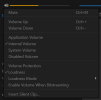
*channel labels SL/SR above is not accurate since those are rerouted as left and right in reality.
Attachments
Last edited:
ernestcarl
Major Contributor
I'm currently using my bass-limited center speaker with a little help/reinforcement from the front left and right speakers to slightly boost its low end extension:
View attachment 331444
*before somebody complains the bass is "too flat", I already use loudness compensation DSP in JRiver to boost the bass at low listening volumes (well, maybe not all the time, but more often than not it is enabled by default).
Indeed, I can hear intrusive midrange sound coming from the sub and LR channels combined if the center itself is muted/turned off at high volume levels. However, in this case it does not matter as the midrange SPL level outside the center speaker itself is sufficiently low enough/suppressed when the center channel speaker is turned on or playing -- not to mention, when the rest of the other speakers are playing in MCH mode.
View attachment 331437 View attachment 331438
*channel labels SL/SR above is not accurate since those are rerouted as left and right in reality.
Huh! It just occurred to me that I could improve this setup a tad more by simply adding 0.6-0.8 ms of delay to the LR ext signal
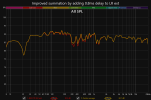
-----
Okay, now I've figured it out!
This does not work:
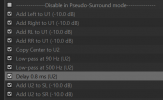
*note: SL/SR label is not accurate as it's rerouted/swapped with the front left and right outs.
This sort of works after verification (but causes a slight misalignment with the rest of the BM channels):
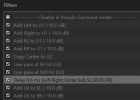
The ff. works (without affecting everything already set up prior) after further additional verification:
*note: SL/SR label is not accurate as it's rerouted/swapped with the front left and right outs.
Attachments
Last edited:
Da cynics
Member
- Joined
- Jun 21, 2020
- Messages
- 82
- Likes
- 39
Therefore audibly significant room-induced lumps in the frequency response do not BEGIN to set in at frequencies that we are listening to in that room.
The second difference is that the path lengths are long enough that you can actually perceive "the direct sound" in the bass region.
I think it makes a lot of sense.
Just what happens to the bass you hear in the headphones
Similar threads
- Replies
- 81
- Views
- 3K
- Replies
- 185
- Views
- 11K
- Replies
- 11
- Views
- 892
- Replies
- 68
- Views
- 8K

